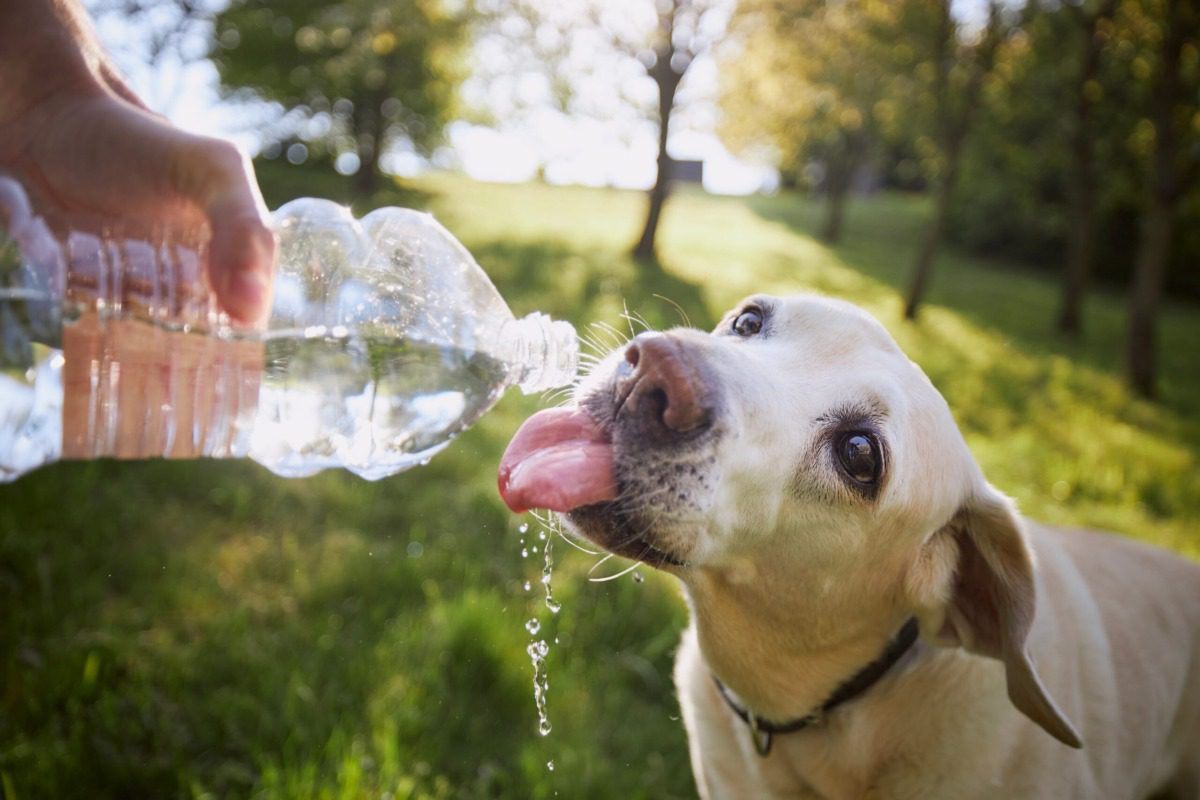
Pet owners: Listen up! (Jaromir Chalabala/Shutterstock)
Two North Carolina veterinarians explain the impact of hot weather on pets, and what pet owners should do to keep their fur babies healthy all summer long.
Summer can signal the start of a joyously sweaty and sticky season for some, but for many pets, the heat in June, July, and August can pose serious risks for their health and well-being.
According to the North Carolina State Climate Office, a heat wave is defined as a period of abnormally hot weather lasting two or more days. Keeping in line with national trends, the Climate Office expects North Carolina to experience an increased likelihood of heat waves, extreme heat events, and rising average temperatures, especially at night.
What does this trend mean for your fur babies? A pair of North Carolina-based veterinary experts tackles the biggest issues every pet owner should consider this summer. Check out this list of 10 tips sure to keep pets safe and healthy until a chilly breeze in the air means autumn has finally arrived:
1. Kick off your summer with a visit to the veterinarian.
There’s no better time to book a check-up with your pet’s veterinarian than the start of summer, advises Dr. Rachel Cocchiaro, a veterinarian at Bahama Road Veterinary Hospital in Bahama. Speak with your vet about any changes in medical history that your pet may have experienced since the previous summer, as some health conditions leave pets more vulnerable to punishing summer heat.
“North Carolina’s summertime temperatures often exceed safe levels well before lunchtime. There are times of the year when, even overnight, the heat does not recede, and overheating can occur any time of the day. Humidity adds significantly to the risk of heatstroke in dogs, as it reduces the efficacy of panting. When making plans for outdoor activities for pets, the heat index should be taken into consideration, not just the temperature,” Cocchiaro says. “Certain medical conditions, like Cushing’s disease, laryngeal paralysis, and any cardiovascular or respiratory deficiencies, can cause significant heat intolerance and put pets into a much higher risk category for overheating.”
2. Learn how hot weather affects your pet’s risk of heartworms.
Summer rain may create an abundance of puddles and pools of warm, standing water in your environments, Cocchiaro says, which puts pets at an increased risk for contracting heartworm disease from mosquitoes. She recommends both preventive care and annual testing against the disease, which can be fatal if left untreated.
“Preventives are available in both monthly or quarterly oral medications, or annual or semi-annual injections provided by your veterinarian,” Cocchiaro says. “Testing for heartworm status is recommended at least annually to provide treatment quickly if an infection is found. There are reports of mosquitoes developing resistance to some preventive medications in some areas of the country, so a consultation with your veterinarian about your pet’s travel habits and living arrangements is advisable.”
3. Learn how to recognize signs of overheating.
The first step in reducing your pet’s risk of overheating this summer, Cocchiaro says, is to learn its unique tolerance for heat. Heat tolerance is impacted by an animal’s breed, anatomy, body condition, age, level of fitness, haircoat, and the environment it’s used to. The American Society for the Prevention of Cruelty to Animals (ASPCA) notes that pets with flat faces like pugs or Persian cats face an increased risk of heatstroke due to their inability to pant as effectively as other breeds.
“Pets with a reduced ability to move air are much more sensitive to heat and experience a significantly increased risk of overheating,” Cocchiaro says. “If a dog is brachiocephalic, overweight, has laryngeal paralysis, is unfit, or is a heavy-coated breed, they will suffer from overheating much faster than a dog without those conditions. Senior and very young puppies are also more susceptible to overheating.”
Cocchiaro outlines the early warning signs of overheating in dogs, symptoms that require immediate intervention.
“Signs of early overheating in dogs may include excessive panting that does not slow rapidly when activity decreases, profuse salivation, a significant change in mucus membrane color to bright red, and a body temperature rising over 104 degrees,” she explains. “If any of these changes are noted, the dog needs to be moved to a cooler location immediately. If overheating progresses and body temperature reaches over 106 degrees, the dog’s mucus membrane color may fade to pale pink or purple and grey. At this point, they are likely dehydrated, vomiting, and diarrhea may begin, and veterinary care is essential to their recovery.”
4. If your pet shows signs of heat stroke or dehydration, act immediately.
If your pet exhibits symptoms of lethargy, weakness, seizures, or coma, it’s possible that organ damage and death can follow, Cocchiaro warns. That’s why it’s so critical to act preventively rather than reactively, she explains, ensuring your pet has a cool environment to spend their days and nights.
“Severe heatstroke can cause death even with veterinary intervention, so prevention and early intervention are key to helping your dog do well in the summer heat,” Cocchiaro says. “Move the pet to a cool, shaded area, provide air conditioning, and apply cool—not cold—water. If the pet is not vomiting and is conscious and mobile, cool water may be offered. Seek veterinary care.”
5. Never leave your pet alone in a parked vehicle.
Not only is it illegal in the state of North Carolina to leave a pet unattended in a parked vehicle; it’s a recipe for danger to pets, especially on sweltering summer days, says Dr. Alex Lynch, an associate professor of emergency and critical care medicine at North Carolina State University College of Veterinary Medicine.
“Cars get very hot very quickly, and pets will develop issues quickly since they are unable to escape the hot weather,” Lynch says. “It’s important to take your pet with you, or leave them at home instead.”
6. Be mindful of the heat and sun during daily walks with your dog.
Both Lynch and Cocchiaro recommend saving daily neighborhood walks with your pup for early morning or late evening and nighttime, when the asphalt isn’t boiling from the sun’s heat. If that isn’t possible with your work schedule, consider purchasing some protective accessories for your dog’s paw pads.
“Asphalt can burn paws, especially those with minimal fur,” Cocchiaro says. “If your dog is going to walk on hot streets or sidewalks, consider getting them booties to protect their paw pads. Have them adjust to the boots slowly, and examine their feet after every use to make sure no pressure sores or rubs develop from use over time.”
Not sure if the asphalt is cool enough for your pup’s paw pads? Test it yourself first.
“Asphalt can stay hot long after the air temperature cools down. Feel the pavement. If it is not comfortable for your hand, your dog may benefit from walking on a different surface, using protection, or delaying walks,” Cocchiaro recommends.
7. Monitor your pets around bodies of water.
While some dogs enjoy a summer day at the shore as much as your average beach bum, others may not be equipped to deal with its waves, salt content, and other variable conditions. Lynch recommends closely monitoring your pets around any body of water this summer—swimming pools, small ponds, and lakes included—to prevent injury or illness from falls, drinking non-potable water, or drowning.
“Pets can drown, especially if they fall in and cannot get out. Always watch them closely, and ideally, protect them by having fences around pools,” Lynch says. “Many dogs love to swim, so start slowly and let them get used to water gently with you there to help them. Pet life jackets might also be useful. Finally, make sure they drink fresh water, not sea or lake water.”
8. Care for your pets’ anxiety around fireworks shows.
We may be looking forward to the Fourth of July each year for its bombastic displays of fireworks, but our pets surely aren’t. Lynch warns that the loud noises caused by fireworks can send some pets into extreme distress, so it’s critical to plan ahead in order to provide a soothing environment for your fur babies before, during, and after fireworks shows in your area.
“Some pets will be so distressed by fireworks that they run away, hide, or hurt themselves trying to escape,” Lynch warns. “Keep pets indoors with curtains closed and soft music playing. Give them a safe, quiet space, and talk to your vet about calming medicine. These medicines work best if they are given before a distressing event happens. Talk to your veterinarian a week or so before a major holiday, like July 4, to get a good plan in place.”
9. Keep pets safe in the yard and garden.
Sun-filled days may draw those with a green thumb into the yard or garden this summer, but before bringing your pet outside with you, consider the potential dangers it faces from contact with chemicals.
“Read all the labels on any herbicide, pesticide, or insecticide that is used on your property,” Cocchiaro advises. “Exposure to traditional lawn chemicals has been linked to certain types of cancers in dogs. Many applied products have time periods during which exposure to treated areas should be minimized.”
10. Keep an eye out for potential pet hazards during hikes.
Finally, Lynch advises remaining alert during summertime hikes with your pet, as dangers may lurk in the grass.
“Snakes are more active in summer and can bite curious pets, especially in tall grass or wooded areas,” Lynch says. “Keep pets on a leash and away from brush or logs, if possible. We have venomous snakes here in North Carolina, so if you think your pet has been bitten, take them to a veterinarian promptly for evaluation.”
This article first appeared on Good Info News Wire and is republished here under a Creative Commons license.
Related: The cutthroat Midwest breeding ring behind North Carolina pet stores

The 6 most ethical aquariums & zoos in North Carolina
Our look at the six most ethical zoos in North Carolina includes aquariums, museums, and "the best zoo in the country." In the 2011 film “We Bought...

Go Batty: October is Bat Appreciation Month
While Halloween is undoubtedly the biggest jewel in October’s crown, there’s another reason to celebrate it: October is Bat Appreciation Month....

Endangered species in NC: What they are and how to help
Learn about five species you may not know are endangered in North Carolina. At any given time, hundreds of species that call the Tar Heel State home...

10 birds migrating through North Carolina this fall
Every corner of North Carolina can see migrating birds in the fall, and we’ve gathered 10 you don’t want to miss. You don’t need us to tell you that...







